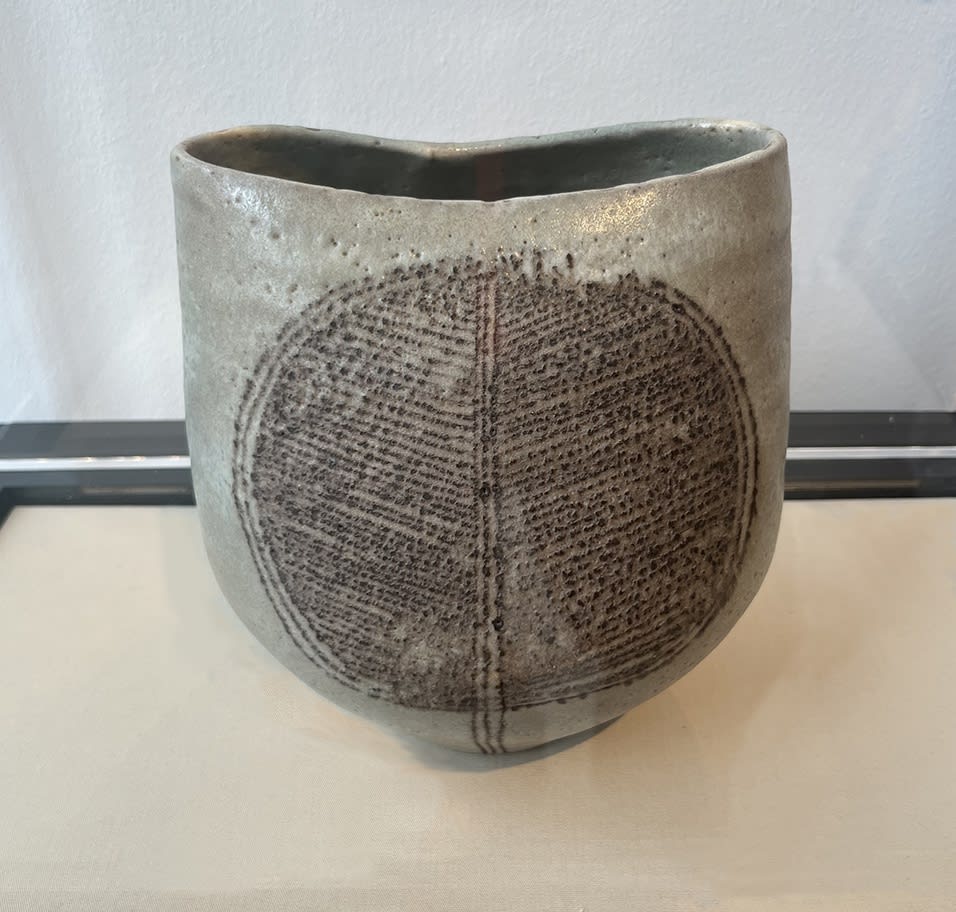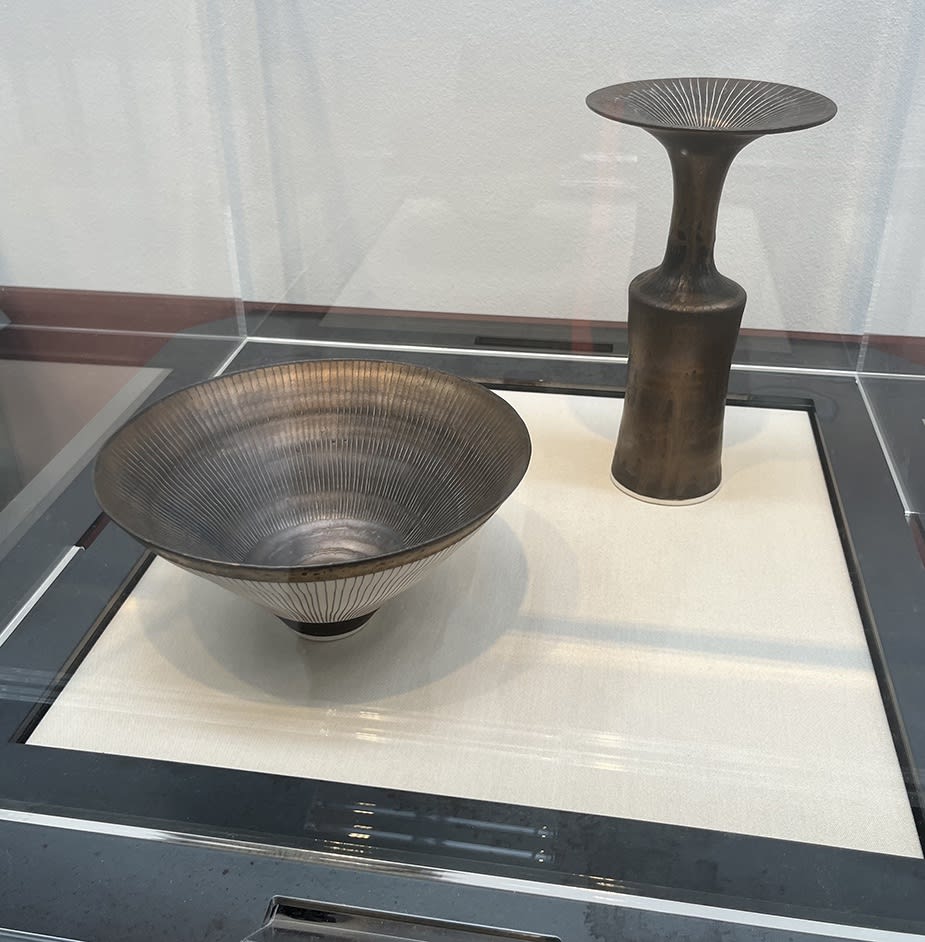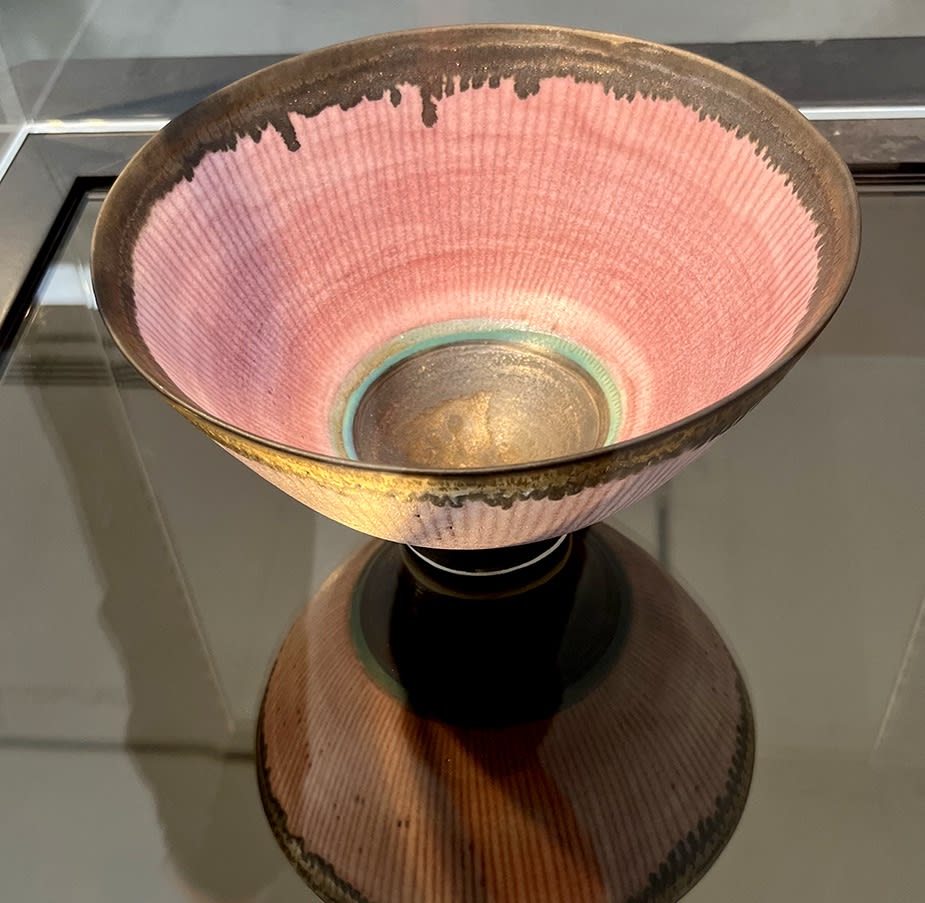
Lucie Rie vase with leaf design
The exhibition is beautifully conceived and has work loaned from public collections throughout the UK. These include the Sainsbury Centre for Visual Art (SCVA), UEA, Norwich. There are many beautiful pieces lent from the V&A Collection, (where there is a recreation of Rie's London studio), York Art Gallery - Centre of Ceramic Art (CoCA), and a few private collections. The blue chip loan sources assure the quality and consistency of the work on show.
The only slightly under represented aspect of the exhibition is that there are only a few works from her beginings in Austria. Lucie Gomperz - né Rie trained at Kunstgewerbeschule, Vienna, enrolling in 1922 and started her professional career, after setting up her first studio in 1925. From the two examples that are displayed, a burnished terracotta teaset and tiny earthenware vessel, it is evident that she was influenced by early twentieth century scandinavian modernist design and roman pottery. However her lean, elegant aesthetic developed its own assured forms early on and it is not hard to see why her pots quickly found their way into international exhibitions. A few more examples of her work from this period would have been fascinating, as by 1937 Rie had won a silver medal at the Paris International Exhibition.
Shortly after receiving this accolade Austria was annexed by Germany and she was compelled to leave her home in Vienna, arriving in London in 1938 with her husband Hans Rie. Although already making a name for herself outside of Vienna, her arrival in Britain was unheralded and Hans left her almost immediately to live permanently in the United States. Lucy Rie stayed and set up her studio and home in Albion Mews in Paddington. At the beginning of WWII London was an artistic backwater when compared to Vienna or Paris. At first it was difficult to establish herself. Rie earned a small income by making ceramic buttons she sold to London couturers. There is a selection of these from the SCVA, Norwich and the V&A in the exhibition. Even these small, fashion accessories are exquisitely formed.
Despite her early success in Vienna, Rie quickly realised as a refugee in Britain that her future was in the balance, unless she could find a kindred spirit. Someone sufficiently well-known to be recognised as a mentor. Rie met the English potter Bernard Leach at the Little Gallery, North London. He had spent time in Japan learning eastern pottery techniques and was, at the time of their meeting, well-known as the father of the British Studio Pottery movement. Shortly after striking up an initial friendship she decided to take classes Leach led at Dartington College. In order to run a studio and get her hands on scarce materials during the war, Rie needed Leach's support and influence to gain the relevant permits. Which he gave. However, even with his intervention, the British Board of Trade turned her application down, initially. Despite this setback they became lifelong friends.
Rie's approach to her pottery was very different to Leach. Where her work can be identified by its intense colour, monochromatic grounds, metalic glaze, fine modelling and sculptural balance, Leach's work has a wholesome quality, they are robust often glossily glazed pots, formed around traditional European, Chinese or Japanese shapes with caligraphic marks on the surface.
The exhibition has a wider selection of Rie's vessels from the 50s than from previous decades. This could possibly be because the studio was more productive, particularly when potter Hans Coper was working with her, first as her assistant and later as her business partner. Pieces made during this period have a more archeological feel. Sculptural shapes are honed down to new sculptural simplicity in form. Rie's earlier interest in her uncle's roman pottery collection is evident in their shape and decoration. A simple leaf design on one vase underlines its perfect combination of shape and function. Some have a thick layer of volcanic glaze, that give her fine forms heft and elemental colour. They look as if they've been buried for millenia and re-discovered. Hans Coper worked for Rie for ten years, and went on to establish his own studio in 1958, becoming one of the most respected potters of the mid-twentieth century in his own right.

Lucie Rie bowl and vase with metallic glaze
These dark forms lighten in colour and profile, as they move into the 60s and early 70s. Citrus yellow and rose are added to her colour palette of blue, taupe and bronze. It is like the sun coming out. This move coincided with her time teaching at Camberwell School of Art, South London. And a period when potter Emmanuel Cooper worked for her in the studio as her assistant. Cooper became a well-respected exponent in contemporary British ceramics, achieving international recognition as a potter, political activist, writer and critic. The pieces from this period are distinguished by broad, flared openings, fine edges on shallow bowls and long-necked vessels of incrediblely fine detail. The forms coming out of the studio at this time took unimaginable skill to realise. One of the last pots she made when she was in her late 80s, is one of the exhibition's highlights, it appears lit from within.
This is a memorable exhibition and a rare opportunity to compare different periods of Lucie Rie's production, over a long career.
Katherina Klug
In the Kettle's Yard Gallery and House shop you will find two or three beautiful black and white bowls that reference Rie's work by Cambridge-based potter Katherina Klug, (also originally from Austria), and whose work frequently references Lucie Rie's techniques and glazes.
A larger selection of Katherina's work will be displayed in our forthcoming exhibition East To East at Houghton Hall Stables.

Lucie Rie bowl with rose interior
About the author

Paul Barratt
Paul Barratt started working in contemporary art galleries in 1989, having graduated in Fine Art from Goldmsith’s, London University. He initially worked at Anthony d’Offay Gallery, one of the contemporary art dealers, who dominated the London art market in the 80s and 90s. He was approached by the Lisson Gallery to be gallery manager for the influential art dealer Nicholas Logsdail. This was followed by a short period in New York at Gladstone Gallery, to work for visionary art dealer Barbara Gladstone, working with the artist and filmmaker Matthew Barney.
On his return to London, Paul secured a place on the postgraduate curatorial course at the Royal College of Art, to complete an MA. After graduation in 2001, he worked as an independent curator on several projects in Oslo, London, Brighton and Basel, before joining Paul Vater at his design agency Sugarfree in 2004. He has worked with Paul ever since.



